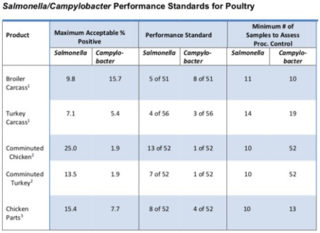A performance standard is a metric that USDA’s Food Safety and Inspection Service uses to evaluate the potential presence of pathogens on FSIS-regulated products, including meat and poultry. The Salmonella performance standards apply to an establishment’s overall process control, not to individual products.

For poultry products, including broiler and turkey carcasses, chicken parts, and not ready-to-eat comminuted products, the FSIS uses a “moving window” approach. The results are used to determine whether or not an establishment meets the performance standard on a continuous basis. First, the FSIS evaluates samples taken within an initial 52-week period, which is not necessarily a calendar year. Then, every week, the 52-week period “moves up” one week, adding a new week’s testing result and removing the oldest week’s results.

A test is considered positive when any Salmonella organisms are found. Federal law allows establishments to have a maximum of 9.8 percent of Salmonella-positive broiler carcass samples, 7.1 percent of turkey carcass samples, 25.0 percent of comminuted chicken samples, 13.5 percent of comminuted turkey samples, and 15.4 percent of chicken parts before they fail to meet the performance standards.
For raw ground beef products, the FSIS uses a vastly different approach. Under the existing sampling program, FSIS determines whether establishments meet the Salmonella standard by testing randomly selected product samples using a risk-based, three-category establishment classification system. The maximum number of Salmonella-positive samples allowed for ground beef is 5 of 53, or 7.5 percent.
However, some beef performance standards may change soon.
On Oct. 28, 2019, the FSIS published a notice in the Federal Register detailing proposed changes to the Salmonella performance standards for raw ground beef and beef manufacturing trimmings, the primary component of raw ground beef. Specifically, the FSIS seeks to:
- implement a 52-week “moving window” approach; and
- collect and analyze at least 48 samples per year for each establishment producing greater than 50,000 pounds of ground beef or beef manufacturing trimmings per day.
(To sign up for a free subscription to Food Safety News, click here.)

